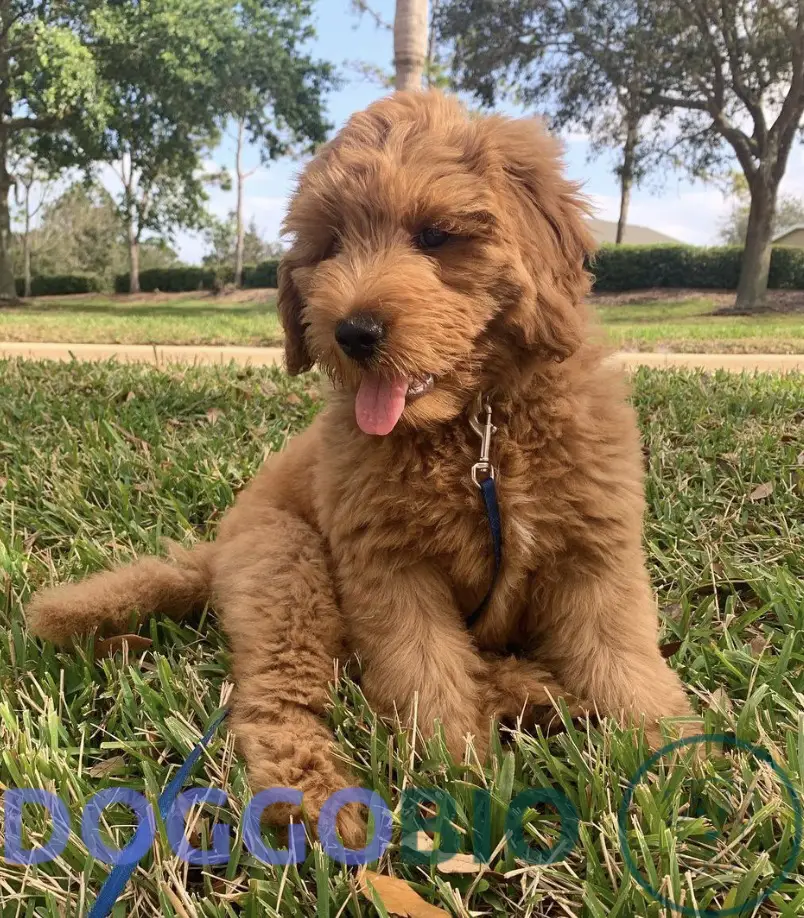In designer dog breeds, one shining star stands out for its remarkable combination of beauty, intelligence, and a heart full of love. Allow us to introduce the F2B Goldendoodle, a captivating canine companion that will undoubtedly steal your heart from the very first wag of its tail.
The F2B Goldendoodle is the offspring of two generations of Goldendoodles, resulting in a unique and enchanting blend of traits.
In this article, we will explore the captivating world of this breed and delve into its stunning coat variations, trainability, and loving temperament. Discover why the F2B Goldendoodle is the perfect companion for those seeking a harmonious blend of beauty and playfulness.
A Brief Overview of f2b Goldendoodle
| Size | Varies based on size (Teacup, Toy, Mini, Medium, or Standard) |
| Temperament | Easygoing, calm, friendly |
| Exercise Requirements | 30 to 60 minutes per day |
| Lifespan | 12 to 16 years |
| Coat | Wavy or curly single chocolate coat |
| Shedding | Low |
What is a f2b Goldendoodle?
F2B Goldendoodle! This second-generation backcross is created by breeding an F2 Goldendoodle with a purebred Poodle or an F1 Goldendoodle with an F1B Goldendoodle.
By incorporating the purebred Poodle, the F2B has a higher chance of being low shedding and allergy-friendly, making it suitable for individuals with pet allergies. These Goldendoodles typically have curlier coats, emphasizing the need for consistent grooming.
It’s worth noting that all Goldendoodles, regardless of their generation, require regular grooming. In terms of percentages, the F2B Goldendoodle is approximately 62.5% Poodle and 37.5% Golden Retriever. However, it’s important to remember that genetics is not as straightforward as numbers suggest, just like individuals from the same family can possess different traits.
Some may also use “multigenerational Goldendoodles” to describe F2B Goldendoodles, F3, F2BB, or any subsequent generations beyond that.
What is a Goldendoodle?

The Goldendoodle, or the Groodle, is a famous hybrid dog—a cross between Poodles and Golden Retrievers.
Despite their immense popularity, they are not officially recognized as purebred by the American Kennel Club. Instead, they are intentionally bred for their low-shedding qualities, making them suitable for individuals with pet allergies.
The Goldendoodle Association of North America (GANA) is a dedicated organization for enthusiasts.
Goldendoodle Generations Explained
Let’s explore the generations of Goldendoodles to understand the significance of the “F2B Goldendoodle.”

1.F1 Goldendoodle
The F1 Goldendoodle is the first-generation cross between a Golden Retriever and a Poodle. With a 50/50 blend of both parent breeds, F1 Goldendoodles exhibit many traits, especially in coat type and shedding. Some lean towards the Golden Retriever side with straighter coats and more shedding, while others lean towards the Poodle side with curlier coats and less shedding.
2.f1b Goldendoodles
The F1B Goldendoodle is a first-generation backcross where an F1 Goldendoodle is bred with a Poodle. This generation has approximately 75% Poodle genetics and is considered more hypoallergenic with less shedding and a curlier coat.
3.F2 Goldendoodle
The F2 Goldendoodle is a second-generation Goldendoodle resulting from the breeding of two F1 Goldendoodle parents or an F1B Goldendoodle parent with an F1 Goldendoodle parent. This generation is approximately 50% Golden Retriever and 50% Poodle.
While the F2 shares similarities with the F1, it has hybrid parents instead of purebred parents. The coat traits and shedding in the F2 Goldendoodle are less predictable compared to the F1. If coat qualities are not a priority, the F2 may be a suitable choice.
What Does a f2b Goldendoodle Look Like?

Size, height, and Weight
F2B Goldendoodles come in various sizes, including Teacup, Toy, Mini, Medium, and Standard.
| Size Group | Toy | Mini | Medium | Standard |
| Height | < 11 inches | 11 – 14 inches | 15 – 19 inches | 20 – 24 inches |
| Weight | < 15 lbs | 15 – 29 lbs | 30 – 44 lbs | 45 – 74 lbs |
Coat Colors and Types
In terms of colors, Goldendoodles come in various shades, not just golden. Popular color options include apricot, red, white, chocolate, cream, party, merle, and black.
Temperament and Personality
F2B Goldendoodles have a naturally high level of excitement. They thrive in the company of people and other animals, displaying affection and gentleness. Their eagerness to please makes them easy to train and requires relatively straightforward care.
While the generation of a Goldendoodle has a limited impact on temperament, some individuals perceive F2B Goldendoodles to exhibit a character more akin to a Poodle than a Golden Retriever.
Training and Exercise Requirements
F2b Goldendoodles are easy to train and respond well to positive reinforcement. Socialize them early and use treats and encouragement to teach them new things.
They are energetic and need daily activities to stay engaged. They can adapt to apartments but require exercise and outdoor time.
Grooming and Cleaning
The Poodle coat inherited by F2b Goldendoodles comes with demanding grooming needs.
- Regular haircuts and daily brushing are necessary. You should remove dead hair and debris at least 2-3 times weekly and bathe for 2 to 3 months.
- Dental hygiene is crucial. Aim for daily teeth brushing, but 3 to 4 times a week is more practical.
- And remember to trim your Goldendoodle’s nails to prevent discomfort and difficulty walking.
Food and Diet
Due to their larger size, F2b Goldendoodles require twice as much food as standard Goldendoodles. You can stick to the same feeding routine, offering frequent meals with smaller portions for optimal nutrition.
Life Expectancy and Common Health Issues
On average, Goldendoodles have a lifespan of 10 to 15 years. However, several factors can influence their lifespans, such as size, gender, generation, and whether they are desexed or intact. These variables can result in shorter or longer lifespans than the average.
While hybrid dogs like Goldendoodles are less prone to genetic dysfunctions, it’s essential to be aware of potential health issues:

1.Sebaceous Adenitis
This skin disease causes inflammation, itching, and thickened skin in the affected areas, such as the paws and eyes.
2.Hip Dysplasia
A common inherited condition, hip dysplasia leads to pain, swelling, and lameness, particularly in larger dogs weighing over 20 pounds.
3. Subvalvular Aortic Stenosis
This heart defect slows down blood flow through the heart, resulting in breathing difficulties, coughing, and reduced exercise tolerance.
4.Cataracts
Cloudy spots that develop inside the eye; cataracts can cause vision impairment and, if left untreated, lead to blindness.
5.Addison’s Disease
This condition affects the adrenal glands, causing excessive cortisol production, weakening the immune system, and increasing the risk of infections and tumors.
How Much Do F2B Goldendoodles Cost?
F2B Goldendoodles typically range from $2200 to $4500 USD. Several factors impact the cost, including size, coat color, breeder’s location and reputation, and the dog’s age.
Is a GoldendoodlesGoldendoodle the Right Dog for You?
With the wide variety of Goldendoodles available, it’s essential to consider factors such as your living space, lifestyle, allergen sensitivity, and breed preferences.
If you reside in an apartment, a smaller F2b mini or toy Goldendoodle may be your ideal choice.
However, if you have a spacious home with ample room, you can consider a medium or standard F2b Goldendoodle.
Regardless of the size you choose, F2b Goldendoodles are known for their endearing, affectionate nature, high energy levels, and intelligence.
List of dogs that are similar to Apricot Goldendoodle
Frequently Asked Questions
Do F2b Goldendoodles Shed A Lot?
No, The shedding level of F2B Goldendoodles can vary, but they tend to shed less than Golden Retrievers. While some hair may be present during grooming, it is less likely to stick to furniture or clothes.
The F2B generation is an excellent option for a lower-shedding Goldendoodle.
Are F2B Goldendoodles hypoallergenic?
Yes, F2B Goldendoodles are hypoallergenic because they release minimal dander (dead skin cells) into their surroundings when they shed. They are even more hypoallergenic than F2 Goldendoodles because they are cross-backed with a Poodle, a breed known for its hypoallergenic properties, rather than a Golden Retriever.
To enhance the hypoallergenic nature of your dog, maintaining a regular grooming routine is crucial as it prevents the release of allergens in your home.
Are Goldendoodles Good With Other Pets?
Yes, F2b Goldendoodles are known for their friendly nature, making them excellent companions for dogs and cats. They exhibit a pleasant disposition and rarely display aggression toward other animals.
Nevertheless, it is essential to note that they tend to be protective of their owners. Therefore, early socialization is crucial to ensure harmonious interactions with other pets.
Is F1B Diferent From F2B Goldendoodle?
Yes.F1b Goldendoodles and F2b Goldendoodles differ in their breeding generations. F1b Goldendoodles are the first backcross generation, while F2b Goldendoodles are the second backcross generation.
- F1b Goldendoodles typically have a genetic composition of 25% Golden Retriever and 75% Poodle because they are bred by crossing an F1 Goldendoodle with a Poodle.
- On the other hand, F2b Goldendoodles can have a similar genetic composition of 25% Golden Retriever and 75% Poodle if they are produced by breeding an F2 Goldendoodle with a Poodle.
However, if F2b Goldendoodles are created by crossing an F1 Goldendoodle with an F1b Goldendoodle, their genetic makeup would be 37.5% Golden Retriever and 62.5% Poodle. So, the genetic composition of F2b Goldendoodles can vary depending on the specific breeding pairings used.
| Generation | Genetic Makeup |
| F1b Goldendoodle | 25% Golden Retriever + 75% Poodle |
| F2b Goldendoodle | 25% Golden Retriever + 75% Poodle |
| 37.5% Golden Retriever + 62.5% Poodle |
Is F2 Different From F2B Goldendoodle?
Yes.F2 Goldendoodles and F2b Goldendoodles differ in their breeding generations.F2 Goldendoodles are the second generation, while F2b Goldendoodles are the second backcross generation.
- The main difference is the Golden Retriever to Poodle ratio. F2 Goldendoodles are 50% Golden Retriever and 50% Poodle, while F2b Goldendoodles can be either 25% Golden Retriever and 75% Poodle or 37.5% Golden Retriever and 62.5% Poodle.
- F2b Goldendoodles are typically taller, leaner, and have curlier coats than F2 Goldendoodles. They are also generally more hypoallergenic than F2 Goldendoodles.
| Generation | Genetic Makeup |
| F2 Goldendoodle | 50% Golden Retriever + 50% Poodle |
| F2b Goldendoodle | 25% Golden Retriever + 75% Poodle |
| 37.5% Golden Retriever + 62.5% Poodle (OR) |
Conclusion
In conclusion, the F2B Goldendoodle embodies the best of both worlds: elegance and playfulness. From their eye-catching coats to their sharp intelligence and loving nature, they are remarkable.
Whether as a loyal family companion or a dedicated training partner, the F2B Goldendoodle brings joy and warmth to any home. Their unique traits make them a treasured addition to families and individuals.
If you’re seeking a canine companion that is as beautiful as it is affectionate, look no further than the delightful F2B Goldendoodle.

Pingback: Straight Hair Goldendoodle: Beauty Meets Love 2023
Pingback: Red Golden doodles: A Interesting Canine Companion 2023